After a Long time
Finally, I think this site's gonna get a well deserved makeover. I've not been able to update this blog for long.
Now, after exams, change is in the air.
Change the world!
Finally, I think this site's gonna get a well deserved makeover. I've not been able to update this blog for long.
Now, after exams, change is in the air.
My exams are going on now in college and I'm bound to books for some time, but not for long. Next month I'll be out in the wild again!
But this time, instead of just getting knowledge and doing small things (see other posts), i'm thinking big. This year I set a resolution to switch my room to complete Renewable energy powered in the coming years till i complete my graduation. Its just 2 years left now and I've done nothing!
A genuine excuse for that is because this was my first year in college and i wasn't settled properly at a place.
Talking of place, this 2 room rented apartment where I'm living now has ample renewable resources for my needs(I guess). Being on the top floor, it receives full day solar blast, and good wind too, maybe due to nearby mountain range 'Shivalik Hills'.
So the plan is to make a device that captures Sunlight and Wind simultaneously. Any ideas?
Cya
Look at the title of this post, understood anything? The last two words are okay but got any guess whats that pingy pongy stuff. Well, let your inner curious feeling read the rest of the post to satisfy itself.
Ping-Pong CD Concentrator is an idea that flashed into my mind when I saw the shiny side of a pile of useless CDs & DVDs lying on my desktop. The ping-pong element comes from a common plastic ping pong ball thats used to play table tennis. I was a table tennis player in school.
So, imagine a CD placed on a ping pong ball with shiny side up. Ball fits into the hole in centre of CD and if you fix the ball there, what you get is a kind of rotating mirror which can rotate 2 sides either right-left or front-back. Lets visualise it;
This is what it should look like. Attach the ball to the CD using adhesive.
This rotating type of mirror-like arrangement is the precursor to our Solar Concentrator. Quite intuitively, you can see that this CD can direct light falling on it to any side wherever it rotates. This is the basic concept that is used in Heliostats (Large Sun Tracking mirrors).
Now suppose you collect some waste CDs lying around and buy an equal number of ping pong balls (very cheap) and then build individual units like described above. Arrange them on the floor and fix them there using plasticine or clay (kids play with) in such a way that all of them point toward a common centre. The image below will make things clear;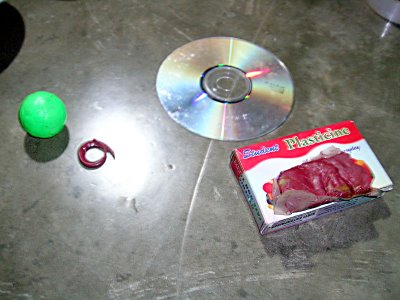

I made a demo project as you can see on the right. All the individual units are concentrating sunlight on a circular point on a wall (not in picture).
This is a nifty little idea to concentrate sunlight easily. Equate this with what is shown below;
it is a power tower with hundreds of heliostats concentrating sunlight on the top of a tower.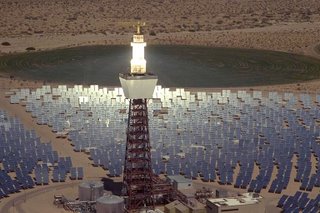
Like this idea? Tell us! Your Suggestions invited. More updates to this will continue.
Start collecting waste CDs now!
C ya
Hello!
So, finally I got some time and internet connection to update my blog after such a long time. Actually, I just joined college and moved to city, so I needed some time to settle down.
Moving on!
Remember the Sun Tracker Project I made as high school project which won me 2 national awards?
Well now I thought of working on it further and submit another project report to Indian Institute of Science (IISc) Scholarship program for undergraduate students. Earlier project report was just a plain ol' MS Word document made on a borrowed computer, but this time I had my own laptop and good knowledge of graphic designing and animation to work with. So naturally, this time it was a visual delight to go through the report. Hope that admission officers at IISc also say the same ;)
Here, I'll provide some data I collected with the working model and some illustrations showing the design, structure and circuit diagram of the model.
The basic concept on which the electronic circuit works is as shown below;
When the two oppositely placed sensors are equally exposed, the tracker is in stable state i.e. not rotating. But when one comes under shadow it signals the circuit to rotate the panel.
Actually, the 2-axis sensor looks like this; You can see clearly the sundial kind of effect. In this image light source is at front right side of the sensor as seen by you.
You can see clearly the sundial kind of effect. In this image light source is at front right side of the sensor as seen by you.
Below image shows the basic schematic of the tracker design as I made it; notice the position of the sensor. A ball & socket type of joint is used which gives full freedom of rotation in two dimentions. Actually, this design, as it was later found, is not stable enough for rough applications. See for instance, in windy weather, fast moving wind will put a lot of strain on the drive belts because the torque (rotating force) on the back side of the panel due to wind would produce a lift force which would be imbalanced on the different halves of the panel.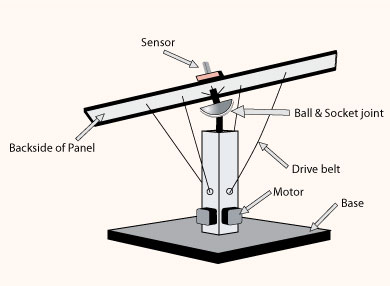
![]()
And this is an image showing the basic, very cheap and fundamental circuit design used in a Sun Tracker. What the IC in this circuit does is to subtract the two values of voltage at oppositely placed sensors on the sensor board, here S1 & S2.
Difference of the voltages with some current amplification is what is used to drive the motor. And the motor is a basic DC type so that when the output voltage (after subtraction by IC) is positive the motor rotates clockwise and when the output is negative the motor rotates in the opposite sense.
For 2-axis rotation two of the circuits are required with 2 motors, or a single motor with a dividing gear. S3 and S4 are part of the 2nd circuit.
e-mail me for more info on this project. If you know anything about Sun Trackers please take some time to share it with me. Thanks! My e-mail address: mridul(dot)nangal(at)gmail.com
Summer heat is on and that makes me think!
You may have probably heard of Solar Air Conditioner. It can produce cooling effect by absorbing heat from Sunlight. Normally, these types of ACs are absorption type refrigeration systems using Ammonia cycle, salt and vapor pressure stuff.
But these are still limited to research labs and some commercial applications.
In this post I'm going to talk about using Electricity (Solar) to get some extra points of efficiency from your existing AC.
The inspiration for this idea came from ice factories, industrial cooling towers, our fridge and the thermodynamics chapter in my physics textbook.
Lets start with the basics i.e. physics (basics|physics, it rhymes!)
2nd Law of thermodynamics tells us that energy flows in one direction only, whenever there is a net increase in the disorderliness (entropy) of a thing, it flows from a less disordered state to more. For example, you put a drop of ink in a beaker full of water, ink spreads i.e. becomes more disordered. You can't expect the dissolved ink to converge and become a drop again. Similar things happen with our drawers and cupboards! Actually, it is the 2nd law of thermodynamics that gives direction to Time. Think about this!
Coming Back to our AC;
An AC or Fridge seems to break this law! Isn't it?
How it can pick out heat from a cold area and throw it in the hot one?
As cold air is more ordered, you can see, AC tries to decrease disorderliness on the in-side and increase it on the out-side. But the 2nd law says for anything to happen in this universe there should be a net increase in disorderliness.
So we can say that if an AC is working, then it throws more heat out-side than it absorbs from in-side. Now from where that 'extra' heat is coming? Of course from the electricity that it consumes.
Now you see why an AC works. Click here if you want to know how it works!
Efficiency?
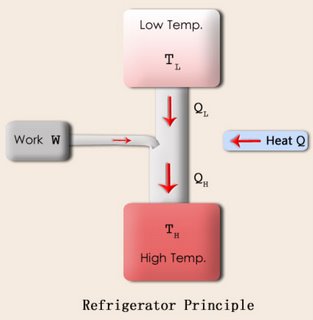 A refrigerator continuously cycles a series of thermodynamic processes to transfer heat from low temp to high temp. As you saw earlier this cycle is not 100% efficient, it has to throw out more heat than it can capture. For an ideal refrigerator (as shown) the thermodynamic cycle is called Carnot cycle and it is called Carnot refrigerator.
A refrigerator continuously cycles a series of thermodynamic processes to transfer heat from low temp to high temp. As you saw earlier this cycle is not 100% efficient, it has to throw out more heat than it can capture. For an ideal refrigerator (as shown) the thermodynamic cycle is called Carnot cycle and it is called Carnot refrigerator.

Click on 'comments' to give feedback on this post.
Sun Tracker, as the name says, is a device that helps a Solar Device { it can be a cell, panel, or dish...etc.} keep track of the Sun from morning to evening.
But there is lot more to know than just this!
Sun Trackers are generally not used for simple solar panels but they're absolutely essential for a solar power plant.
But, if you believe me, Sun Tracker can help increase overall efficiency of a solar installation by over 40%
And I proved it and made a simple device to show the effect. It helped me bag Intel Science Talent Award 2004.
So, lets start with the basics;
How it increases efficiency?


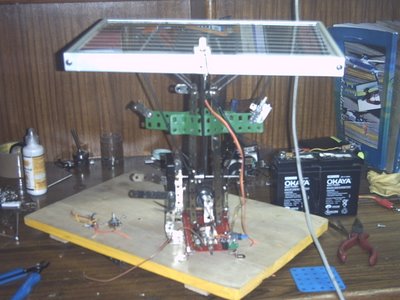
Didn't understand something? Need more data? Do you know more? You like it?
Tell me! Click on 'comments' below, provide your feedback, Now!
Solar energy to Hydrogen, to Electricity. This is the process that'll be used in future solar power plants, as I believe.
Currently, Electricity is directly generated by combustion of coal or gas, but in the case of Solar Energy it can't be done so.
Because, you know, Sunlight is generally intermittent and is unavailable at night, so a storage medium is required, which can be hydrogen. But, hydrogen, as you know, is difficult to store and is still a research topic.
If Offshore Solar concept is used then, there is no use of Hydrogen, as energy can be stored in Rig's own towers {legs}. Read the previous post to know more.
-------
I have nothing to write more today, as I have to delve into some nice big books to study integration and electromagnetic waves.
as I have to delve into some nice big books to study integration and electromagnetic waves.
And also, today was Solar eclipse. I used a pin hole camera to view it at my home. Camera was made using old ivory paper sheet rolled up and another sheet to view the projection. See what I saw,
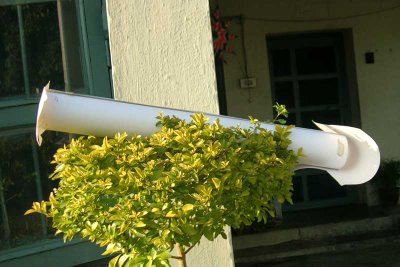 and the apparatus;
and the apparatus;
Today, an idea developed into my mind while reading a physics chapter. Its about energy storage in the sea, to be used with the Offshore Solar {earlier post} project.
Its a quite intuitive idea. You might have observed a phenomenon while playing with water { I do it daily}, that when you try to put an inverted mug into bucket full of water, you have to push it downwards into water and it bounces back when let free.
While pushing it, you are actually trying to oppose a force applied by water from downwards. This force is called buoyant force {discovered by Archimedes}.
Now, I'm trying to visualize a similar thing, for sea.
Imagine a large and heavy hollow tower with closed top {say, a giant pipe with closed end}. Immerse this tower into sea water so that water goes inside and fills it up enough so that it floats. Lets call it "Energy tower"
This tower is now closed from the bottom too, so that water stays inside. Valves are used for opening and closing on both ends.
Imagine that we're generating huge amount of energy from the Solar Rig. To store some energy for night use we'll use a fraction of energy generated during the day to Pump out water from the Energy tower. As water is pumped out of the tower, it rises, due to buoyant force, just like a balloon rises in water, when inflated.
But, its huge weight tries to keep it down and so a very high water pressure starts to build outside the Energy Tower.
As Evening sets in, power production from the Solar Rig ceases and now, our Energy Tower comes to life.
All air and water valves are let open, and instantly, Water gushes in, with huge force.
Simply, place a water turbine at this end to produce power from the gushing water, just like turbines used in Hydro Projects {Dam}.
This I think, is an easy way to store energy at sea and it has virtually unlimited capacity.
I guess it'll work great with Solar Rigs
What do you Say? Tell us by clicking on "comments" below. I wanted to put some pictures here, but couldn't, due to lack of time. I'm preparing for college entrance tests these days.
Also, I've developed a Flash based "Easy read" feature to be used with text based sites like blogs, so that users can easily read text on screen. It's partially developed and it'll take some more time, due to my tests.
This image shows a large parabolic concentrator focussing sunlight at the smaller parabola in the middle which in turn does the opposite i.e. it turns the focussed light into a parallel, but narrow beam of light.
{Click on the image for larger view; (will open in a new window)}
A word about the parabolic shape;
A Parabola is the name given basically to the shape generated when a conic section {A birthday hat oppositely placed over another} is cut by a plane {say a plane sheet of metal} along its side. Mathematical analysis of the cut surface shows a distinct property, every point on a parabolic curve is equidistant from a point and a line. The point is called Focus and the Line is called Directrix. See below.
This property of a parabolic curve leads us to an equation which is used to describe a parabola.
Where 'x' and 'y' are cartesian coordinates { see the big '+' sign in above graph, horizontal line is X-axis and vertical line is Y-axis}. And, 'f' is the focal point of the curve.
The parabolic concentrator you saw in the topmost image is an exact one. Its mathematical equation is:
If you compare this equation with the above one, you'll see that 'f' here is 5 units. So, the focal point of our parabola is 5 units.
Take a look once again, this time with the graph imposed on it {click on the image for larger view};
A parabolic concentrator needs to track the Sun to maintain focus. Sunlight at the focal point of a moderate size parabola is intense enough to cook anything.
Do you want to eat some food cooked on Sunlight, get a cooker first. For more info visit solarcookers.org
These type of reflectors are used in solar power-plants. Visit: www.energylan.sandia.gov/sunlab/overview.htm
All images in this post are my own!
Coming up in a few days a new "easy read" feature which I've developed for this blog. Reading paragraphs with the use of such technique will become very easy. It's a 'Flash' based feature.
Regular updates will continue.
Have your Say!, click on 'comments' link below.
The Second use of the "solar concentrating sheet" {let's call it} I discussed before (see previous post) is the generation of energy from traffic on road. I know you'd probably think I'm talking about some friction or speedbraker thing but..., here I have a totally 'out-of-this-world' idea about generation of electricity from traffic on road.
As you've read in the previous post; tiny reflectors on the sheet can align themselves to concentrate sunlight on any point in space above the sheet; visualise it like this: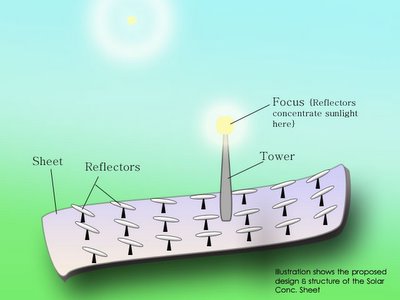
Note that the reflectors are electronically aligned so as to concentrate on the focus.
Now,
imagine that the roof of the vehicles on road is covered with this kind of sheets. Then, whenever a vehicle enters a specific virtual zone marked by distinct radio waves, a reciever on this sheet sends a signal to the reflectors telling the to face the target. Sunlight falling on the roof of the vehicles gets concentrated on a point over the road.
A virtual zone marked by radio waves contains a single focus area.
Suppose that a 500 m long stretch of road comes under this virtual zone and in the middle of the stretch i.e. at 250 m there is a overhead post just like those traffic lights.
Now, if any vehicle enters this area, it's roof top sheet gets the signal to align the reflectors in such a way that sunlight is focussed on the overhead post in the middle of the stretch.
Did you get the idea?
Every vehicle entering the zone will focus sunlight on the post and an energy collector placed at the post will generate power.
So that's how we can get energy without even erecting a Solar power plant.
What are your views on this idea? You can provide feedback by clicking on the 'comments' link.
Thanks for reading. Share your ideas too!